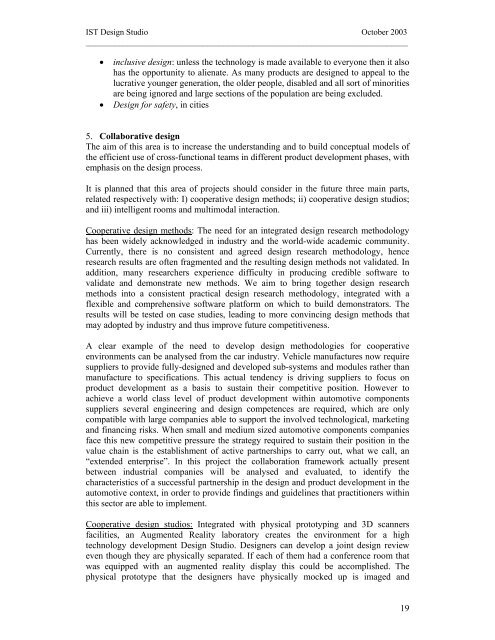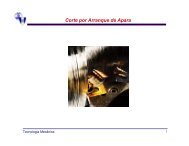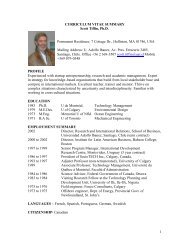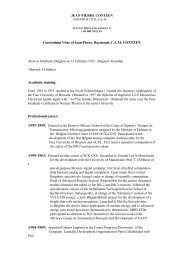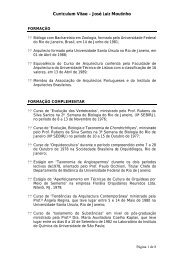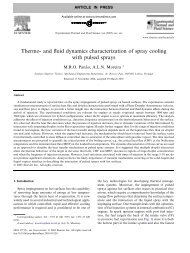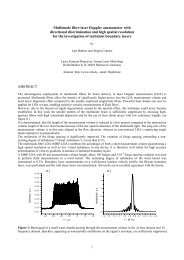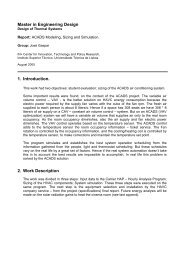THE IST DESIGN STUDIO: a plan for action⦠by Manuel ... - In+
THE IST DESIGN STUDIO: a plan for action⦠by Manuel ... - In+
THE IST DESIGN STUDIO: a plan for action⦠by Manuel ... - In+
Create successful ePaper yourself
Turn your PDF publications into a flip-book with our unique Google optimized e-Paper software.
<strong>IST</strong> Design Studio October 2003_____________________________________________________________________________• inclusive design: unless the technology is made available to everyone then it alsohas the opportunity to alienate. As many products are designed to appeal to thelucrative younger generation, the older people, disabled and all sort of minoritiesare being ignored and large sections of the population are being excluded.• Design <strong>for</strong> safety, in cities5. Collaborative designThe aim of this area is to increase the understanding and to build conceptual models ofthe efficient use of cross-functional teams in different product development phases, withemphasis on the design process.It is <strong>plan</strong>ned that this area of projects should consider in the future three main parts,related respectively with: I) cooperative design methods; ii) cooperative design studios;and iii) intelligent rooms and multimodal interaction.Cooperative design methods: The need <strong>for</strong> an integrated design research methodologyhas been widely acknowledged in industry and the world-wide academic community.Currently, there is no consistent and agreed design research methodology, henceresearch results are often fragmented and the resulting design methods not validated. Inaddition, many researchers experience difficulty in producing credible software tovalidate and demonstrate new methods. We aim to bring together design researchmethods into a consistent practical design research methodology, integrated with aflexible and comprehensive software plat<strong>for</strong>m on which to build demonstrators. Theresults will be tested on case studies, leading to more convincing design methods thatmay adopted <strong>by</strong> industry and thus improve future competitiveness.A clear example of the need to develop design methodologies <strong>for</strong> cooperativeenvironments can be analysed from the car industry. Vehicle manufactures now requiresuppliers to provide fully-designed and developed sub-systems and modules rather thanmanufacture to specifications. This actual tendency is driving suppliers to focus onproduct development as a basis to sustain their competitive position. However toachieve a world class level of product development within automotive componentssuppliers several engineering and design competences are required, which are onlycompatible with large companies able to support the involved technological, marketingand financing risks. When small and medium sized automotive components companiesface this new competitive pressure the strategy required to sustain their position in thevalue chain is the establishment of active partnerships to carry out, what we call, an“extended enterprise”. In this project the collaboration framework actually presentbetween industrial companies will be analysed and evaluated, to identify thecharacteristics of a successful partnership in the design and product development in theautomotive context, in order to provide findings and guidelines that practitioners withinthis sector are able to implement.Cooperative design studios: Integrated with physical prototyping and 3D scannersfacilities, an Augmented Reality laboratory creates the environment <strong>for</strong> a hightechnology development Design Studio. Designers can develop a joint design revieweven though they are physically separated. If each of them had a conference room thatwas equipped with an augmented reality display this could be accomplished. Thephysical prototype that the designers have physically mocked up is imaged and19


